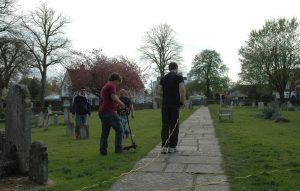A packed audience in Winchelsea heard the very latest archaeological evidence about the location and demise of Winchelsea’s medieval harbour, and a review by leading academics of what current thinking can tell us about the town and its harbour. “Medieval Ports, Ships and Sailors” was an all-day conference organised by the Winchelsea Archaeological Society in co-operation with Southampton University, which is home to Europe’s leading school of maritime archaeology.
The conference was chaired by Casper Johnson, East Sussex County Archaeologist, who also reported on recent excavations at the former Bridge Inn in Winchelsea, where medieval boat timbers were discovered. These were probably being re-used, perhaps as part of the wharf. However, the most exciting news was the discovery of huge timber piles and revetment planking along the edge of what appears to be an inlet in the dockside.
Further light was shed on Winchelsea’s medieval port by Thomas Dhoop, a PhD student from Southampton University who is leading a team investigating the harbour in a project partly funded by Winchelsea Archaeological Society. Thomas discussed auger samples being extracted from the land that is thought to lie over what was the edge of the harbour. A sequence of silts, soils and peat revealed a history of flooding, possible reclamation and silting.
It is hoped that it will be possible to date the peat and therefore the start of the final silting of the harbour. The survey has also found evidence of buildings on the harbour front but their orientation contradicts the assumed layout of harbour plots. In a fascinating aside, Thomas explained how statistical modelling of the way people use streets was able to explain something of the layout of the Winchelsea’s famous grids (these are smaller the closer they are to the port in order to minimise distances in the busiest part of the town).
Prof David Hinton from Southampton University set the Winchelsea story in context by discussing what is known about the development of European ports since Roman times, particularly from evidence unearthed in Southampton and London. In contrast to Roman London, most medieval ports were developed privately and grew in an uncoordinated fashion. This also contributed to the typical layout of port towns.
An even broader context to Winchelsea’s maritime history was provided by Dr Fraser Sturt of Southampton University. He revealed that Old Winchelsea was the victim of an environmental double whammy. The storms which swept it away between 1236 and 1288 were due not only to climate change but also a 1000-year cycle in sea temperatures.
The advent of stormier seas was picked up by Prof Jonathan Adams, who has been excavating medieval shipwrecks around Europe for many years. It appears that medieval shipbuilders responded to deteriorating environmental conditions in the 13th century by constructing stronger ships. An unintended byproduct was a raft of technological innovations that laid the basis for the big post-medieval ships that were to carry European explorers around the globe and underpin the seaborne empires of Europe.
Prof Adams also described his underwater excavations of the extraordinary number of medieval shipwrecks lying under the entrance to the modern harbour of St Peter Port in Guernsey, one of which was built of Sussex oak. The sheer number of wrecks suggests that Guernsey was a key stop-over on the shipping routes from the Mediterranean and Bay of Biscay through the Channel to the North Sea and Baltic.
A broader view of the shipwrecks, which provide the evidence for how medieval ships were built was taken by Dr Joe Flatman of Historic England. Despite the number of wrecks discovered being but a fraction of those documented, the increasing number of excavations and careful collation of the reports from previous excavations was offering new insights into medieval ships.
As Dhoop had pointed out earlier, the evolution of medieval ships was a complex process, not a simple trend from smaller to larger ships. And ship types tended to linger far longer than traditionally assumed. For example, log boats, first seen in Neolithic times, continued to be used in rivers, harbours and along the coast well into the medieval period.
The conference also considered the men who sailed the medieval seas. Dr Julian Whitewright examined medieval pilotage and navigation, in other words, how sailors found their way around. An essential component was the incredibly detailed knowledge that pilots developed of local seafloor geology and their use of lead lines to find their way around. Medieval shipping was a sophisticated and skilled business.
The Southampton University team are continuing their investigation of Winchelsea’s medieval harbour for another week, after which, the results will be carefully analysed before publication.

Photos: Richard Comotto



